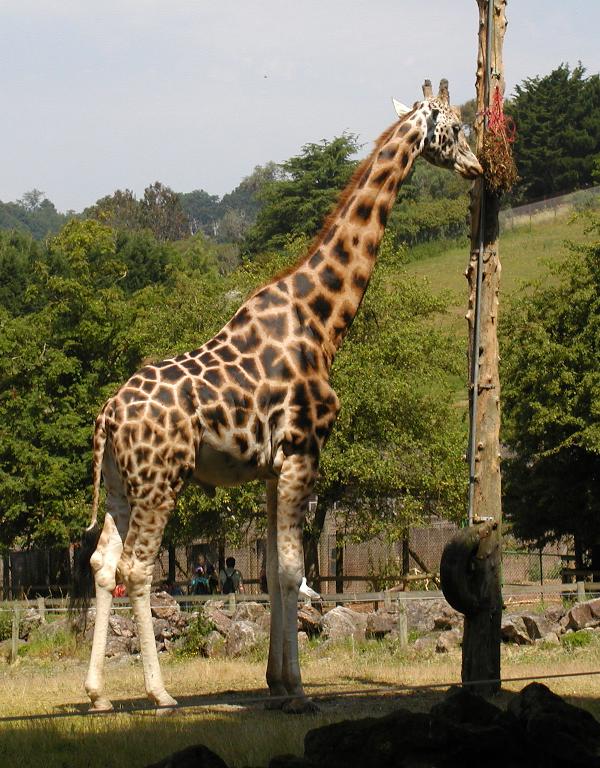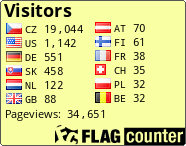CZ
Zirafa Rothschildova
Giraffa camelopardalis rothschildi
Obecné informace Žirafa Rothschildova je nejvyšším savcem sveta. Byla pojmenována po zakladateli muzea v Tringu Lionel Walter Rothschildovi. Prirozeným prostredím žiraf jsou savany a polopoušte. Protože mají dlouhý jazyk a husté sliny, mohou se živit i trnitými vetvemi stromu.
Rozšírení Žirafa je rozšírena v Keni a Ugande. Žije v krovinatých oblastech, savanách a polopouštích.
Zpusob života Žirafy tvorí menší stáda vetšinou po 10 zvíratech, výjimkou jsou stáda tvorená ze 100 a více žiraf. Stádo vede zkušená samice, která rídí veškerý život uvnitr stáda. Žirafy netvorí pevná stáda, a tak se zvírata pohybují volne. Samec se obvykle pohybuje pri presunech na konci stáda. Mladí samci tvorí mládenecká stáda.
Anatomie Výška žirafy se pohybuje od 4 do 6 metru. Žirafa Rothschildova váží 700 – 1200 kilogramu. Mezi význacné znaky patrí velké oci a uši, chudovité nohy s velkými chodidly a tenký ocas s ohánkou, která slouží napríklad k odhánení much. Na hlave má žirafa dva až ctyri ružky (osikony), které jsou u samcu vetší než u samic. Tyto ružky jsou zpocátku chrupavcité, pozdeji zkostnantí. Žádné dve žirafy nemají stejné kresby na srsti. Hojne rozšírený názor, že krcní páter žirafy je složena pouze ze sedmi obratlu, stejne jako u ostatních savcu, je chybný. Žirafa má totiž jeden krcí obratel navíc, ovšem jeden hrudní jí vymizel, což zrejme mnohé badatele zmátlo. Cévní systém umožnuje bránit prutoku krve, aby pri sklonení hlavy nedošlo k poškození mozku hydrostatickým tlakem.
Potrava Žirafy se živí listím a vetvemi stromu, trávou. Dlouhý jazyk (který je až 50 centimetru dlouhý) a husté sliny umožnují žirafám otrhávat listy i na trnitých vetvích stromu a keru. Konzumace potravy a pití zabere žirafe denne približne dvanáct hodin.
Neprátelé Prirozeným neprítelem žiraf jsou lvi, levharti a hyeny. Nicméne žirafy proti nim nejsou úplne bezmocné, jedním mohutným kopem jsou schopny lva na míste zabít.
Rozmnožování Samice žirafy je brezí 14 - 16,5 mesíce. Zpravidla rodí 1 mláde ve stoje. Mláde žirafy je po narození velké až 180 centimetru a už za pul hodiny po porodu se pokouší postavit.
Ochrana Žirafa je zapsána na cerveném seznamu IUCN. Jsou loveny bezohlednými pytláky napríklad kvuli strapci na svém ocasu, který je prodáván jako suvenýr, a nebo je používán k odhánení much. Zbytek mrtvého zvírete zustane na míste nevyužitý. Zatímco žirafy obecne jsou klasifikovány statusem závislý na ochrane, žirafa Rothschildova je v kategorii kriticky ohrožené druhy kvuli nízké populaci. Existuje velmi málo míst, kde lze žirafu Rothschildovu pozorovat v divocine. Za zmínku stojí národní park Nakuru v Keni a národní park Murchison Falls v severní Ugande. Existují ruzné chovné programy, které mají za cíl zvýšit populaci žirafy Rothschildovy, napr. Giraffe Centre v Nairobi v Keni nebo Woburn Safari Park ve Woburnu ve Velké Británii.
Vek Žirafa Rothschildova se dožívá prumerného veku 30 – 35 let.
Zajímavosti o žirafách
•Žirafy odpocívají ve stoje. Behem 24 hodin spí pouhých 20 minut.
•Samci mezi sebou bojují pretlacováním nebo proplétáním krku, nekdy dokonce do sebe narážejí hlavami.
Neco o kesi
Kes je velikostí vetší micro, prosíme budte pri odlovu opatrní, šetrní k "obalu" kešky a pri vyzvedávání a ukládání se dívejte i na to, co se deje nad vámi.
22.8.2009 - keš obnovena po ukradení, její krásný obal (roh z brazilského býka) je bohužel ukraden s ní, ponecháváme ji tedy jako pouhé mikro...

EN
Rothschild giraffe
Giraffa camelopardalis rothschildi
The Rothschild Giraffe, named after Tring Zoological Museum's founder, Lord Walter Rothschild, also known as the Baringo Giraffe, after the Lake Baringo area of Kenya, or as the Ugandan Giraffe, is the second most endangered giraffe subspecies with only a few hundred members. All of those that are living in the wild are in protected areas in Kenya and Uganda. (Recently it has been proposed that the Rothschild Giraffe is actually a separate species from other giraffes and not a giraffe subspecies) While giraffes in general are classified as Lower Risk: Conservation Dependent, the Rothschild Giraffe is at particular risk of hybridisation, as the population is so limited in numbers. There are very few locations where the Rothschild Giraffe can be seen in the wild, with notable spots being Lake Nakuru National Park in Kenya and Murchison Falls National Park in Northern Uganda. There are various captive breeding programmes in place - most notably at The Giraffe Centre in Nairobi, Kenya, and at Woburn Safari Park in Bedfordshire, England - which aim to expand the genetic gene-pool in the wild population of the Rothschild Giraffe. Rothschild Giraffes are easily distinguishable from other subspecies. The most obvious sign is in the colouring of the coat, or pelt. Where the Reticulated Giraffe has very clearly defined dark patches with bright whitish channels between them, the Rothschild Giraffe more closely resembles the Masai Giraffe. However, when compared to the Masai Giraffe, the Rothschild subspecies is paler, the orange-brown patches are less jagged and sharp in shape and the connective channel is of a creamier hue compared to that seen on the Reticulated Giraffe. In addition, the Rothschild Giraffe displays no markings on the lower leg, giving the impression that it is wearing white stockings. Another distinguishing feature of the Rothschild Giraffe, although harder to spot, is the number of horns on the head. This is the only subspecies to be born with five 'horns'. Two of these are 'true' horns at the top of the head, in common with all giraffes. The third 'horn' can often be seen in the centre of the giraffe's forehead and the other two behind each ear. They are also taller than many other subspecies, measuring up to six metres tall (20 ft). Rothschild Giraffes mate at any time of the year and have a gestation period of 14 to 16 months, with one calf generally being born. They live in small herds, with males and females (and their calves) living separately, only mixing for mating. Males are larger than females and their two 'true' horns are usually bald from sparring. They also tend to be darker in colour than the females, although this is not a guaranteed sexing indicator.
About the cache
It is a bigger micro type of cache. Please be careful when you hunt or return the cache and don't forget to check what happens above you!
